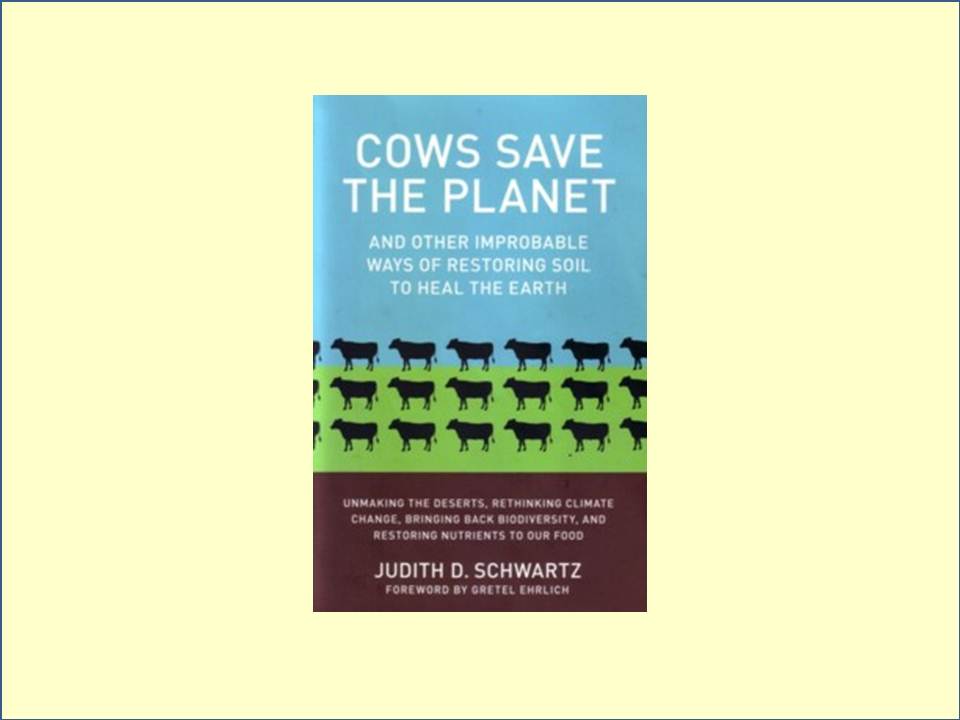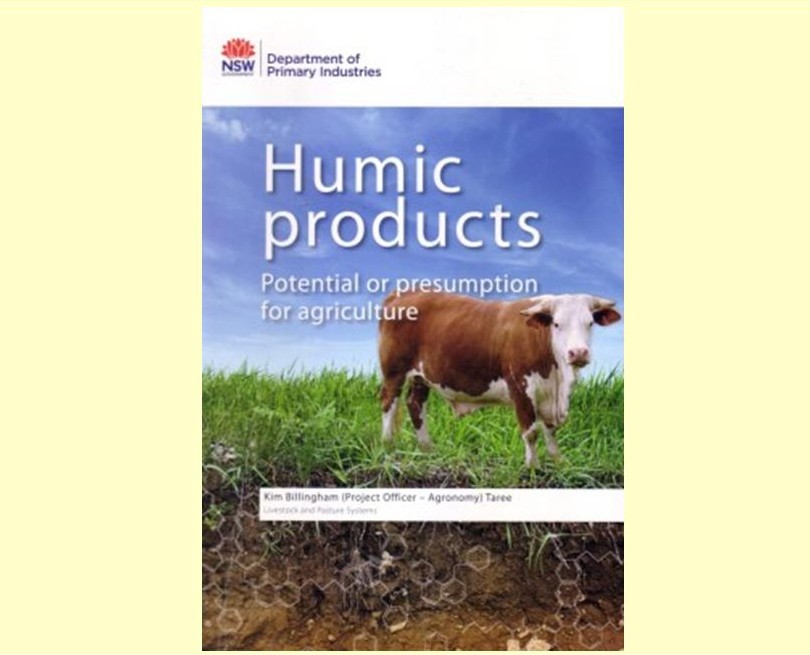Book review “Cows Save the Planet”
Book highlights biology’s role in soil health
By Patrick Francis
When I read that US journalist Judith D. Schwartz had written a book titled “Cows save the planet – and other improbable ways of restoring soil to heal the earth” I was keen to review it as soon as possible. At last I thought an independent writer has undertaken a review of the positive contribution livestock can make to farm ecosystems, rather than condemning them for causing land degradation. To some extent my optimism was rewarded, Schwartz is positive about the roll well managed livestock can play in producing ecosystem services like higher soil water holding capacity, increased soil carbon flows and stocks and enhanced above and below ground biodiversity. But the story’s description about how these are achieved is often too simplistic and fails to recognise the complexity and variability of grazing and cropping ecosystems around the world.
Schwartz is mainly writing for a US audience but draws a great deal on the knowledge of Australian grasslands ecologist and soil carbon advocate Dr Christine Jones. The other major information source is Allan Savory who is one of the originators of holistic grazing management. The reader is quickly introduced to the tenor of the book in its Forward written by Gretel Ehrlich. She says: “ Since I met Savory in the 1980s, the health of the planet has deteriorated seriously. Too few paid attention or took action. We now have a global emergency on our hands: climate change and the desertification of the earth’s surface.” But she continues: “After taking Savory’s weeklong seminar in the early 1980’s, I changed the way I ranched and handled cattle and the way I thought about grass, sunlight, water and soil. I began considering the whole ecosystem, not just bits and pieces, each of which needed help…”.

The change Ehrlich refers to has been happening for 30 years and in areas of pastoral Australia has been widely adopted by livestock farmers. There is a critical reason why it’s happened more in Australia’s pastoral zone and less in other countries extensive grazing areas and that is legal private ownership of land title. In Australia pastoral land is either freehold or 99 years leasehold. So farmers have control over the land they manage even if it involves tens of thousands of hectares as happens in central and northern Australia. In the US much of the pastoral grazing zones is government owned with grazing rights provided on short term basis. In many African countries titles are non-existent as is the case in much of central Asia.
In covering the debate about rangeland desertification and its prevention, land title ownership is a critical issue, so to is access to scientific and practical expertise, access to financial capital, the presence of transport and processing infrastructure, and the presence of relatively stable livestock market prices. All these combine for farmers to make informed decisions with a degree (as far as nature and markets prices will allow) of certainty. Australian farmers have privileged access to all of these vital components of agriculture and have been constantly evolving farming methodologies to suit their business financial circumstances, environmental and ethical outlooks, and the state of health of their farm ecosystems.
Unfortunately in this book the potential for causing desertification or its opposite soil regeneration is not shown by Schwartz to be related to ecosystem variation based on soil type, soil food web, rainfall amounts and pattern, temperature and evapotranspiration, existing vegetation types, and previous management history. The impression is that all farm ecosystems are similar in terms of these characteristics, are all degraded in the same way and extent, and all can be subsequently improved by paying attention to their biological health. Only in the last chapter is the reader alerted to enormous variations that exist in nature in soil and vegetation quality and characteristics.
After covering Savory’s solutions to desertification Schwartz turn her attention to the “Return of Lost Water”. In one of the most interesting chapters in the book she covers the New Water Paradigm introduced by three Slovakia and Czech Republic hydrologists who argue the importance of maintaining permanent soil cover to aid rainwater infiltration.
“According to our estimates, each year over 700 billion cubic meters of rainwater vanishes from the continents. This is water that in the past had been soaked and saturated in soil, and evaporated in the atmosphere it contributes to sea level rise. The most urgent challenge of present civilization is to understand that the drying out of landscapes has a much more serious impact on climate change than an increase of CO2 in the atmosphere,” hydrologist Kravick says.
After the water chapter there are three chapters about food quality, soil biodiversity and land ownership associated with grain production which I found contained an enormous number of anecdotal opinions about facts which could be contested. These chapters move into the realms of farming ideology or a “belief system that becomes a religion” rather than agronomy tested by science. Here are some examples:
- Quoting Dan Kittredge a US farmer who also sells mineral products: “Typical cropland has about five thousand (bacteria and fungi) species, and we need at least 25,000 for the plants to function anywhere near their potential.”
- For me, it comes down to whether you’re choosing the chemical model or the biological model. To get high-quality nutrition, it’s got to be the biological model.”
- …chemical fertilisers have the effect of depleting soil compounds that they don’t contain, including soil organic carbon and trace minerals.
- Quoting John Kempf a US farm consultant and supplier of Dan Kittredge’s mineral products: “Kempf’s approach centres on supporting plants through stages of health so that they form complete proteins.”
- Quoting Dan Kittredge: “We can take areas that can’t grow crops, identify the limiting biological factors, and work with that. Stone dust and seawater: That’s all you need.” Five paragraphs further on: “Nature is complex, functioning at a level beyond or perception.”
- Around the globe farming operations are being consolidated and switched to commodity monocultures, and management is falling to a generation groomed to use chemical inputs as traditional know-how fades into the past.
The last quote is completely out of step with the direction cropping is taking in Australia with an overwhelming transition in the last two decades towards conservation farming. Not only are younger generation farmers opening their minds to the importance of a holistic approach to improving soil health combining biological, physical and nutrient components but also recognise these ensure higher crop water use efficiency, organic carbon content and nutrient availability, resulting in lower fertiliser and energy inputs per kilogram of grain. Farmers are being exposed to a wide range of alternative approaches through grower research organisations with many of the biological experts quoted in the book like Dr Elaine Ingham and Dr Jill Clapperton running workshops for them.
Changing farmers practices is not simply a matter of adopting an alternative approach, then branding those not involved as food, soil and environment degraders. Schwartz has fallen into this trap in these three chapters. What farmers need to facilitate change is combinations of credible ideas which are practically and scientifically based. Fortunately she takes readers down that path in chapter nine through the experience of Jay Fuhrer, district conservationist with the Natural Resources Conservation Service in North Dakota USA. He is a farm advisor like many in Australia who started off treating symptoms of narrow focused methods who have transitioned to understanding the big picture.
“The first half of my career I totally wasted. I was busy treating symptoms,” Fuhrer says. “I hadn’t seen the matrix yet. You start to see a few soil health dots. When you connect the dots, an interesting thing happens: You see so many other dots that come into focus.
“What to a farmer has more worth than the land? When you come to a farmer with mineral support, biodiversity, ways to make it better. It’s a whole different thing.”
Fuhrer takes the author to visit a range of farmers who have adopted a holistic management approach. They are not anti chemicals or anti fertilisers but they know what the combination of approaches can produce given the soil type, rainfall and previous history of farming methods that defines individual farms. The positive outcomes they are achieving for their farm ecosystems as well as profitability is being mirrored by the majority of Australian farmers that are responsible for the bulk of the nation’s grain production and pastoral beef and sheepmeat production. Had Schwartz devoted more of her book to studying their evolving success stories rather than just the last chapter, its impact would have been far greater.
So who should read the book? It is a positive story for agriculture so observers and commentators would gain from reading it. Readers new to the industry will gain an understanding of the important role that biology plays in farming and healthy food production but should realise the balanced approached needed and demonstrated in chapter nine is a minor component of the story. It has little to offer holistic farmers, other than the ‘feel good factor’ associated with reading about ideas that compliment what they have adopted. More conventional farmers would be more likely to embrace the book if the ideas in chapter nine were transferred to chapter one and subsequently connected to the ideas of holistic orientated scientists. As it is these farmers are likely to feel confronted by a story that basically condemns them for growing monocultures and being land and water degraders as a result of using chemical fertilisers and pesticides.
“Cows Save the Planet” by Judith D. Schwartz is published in the US by Chelsea Green Publishing, www.chelseagreen.com



